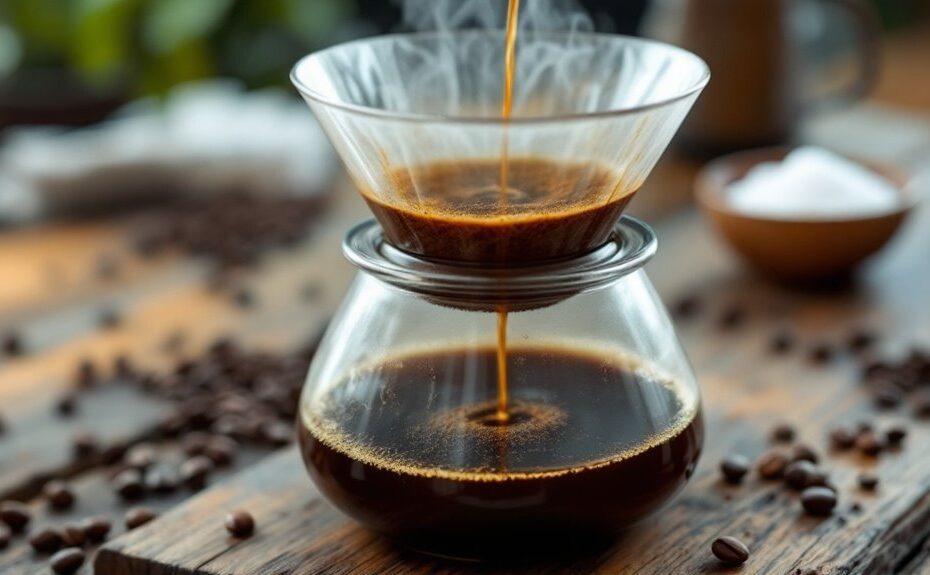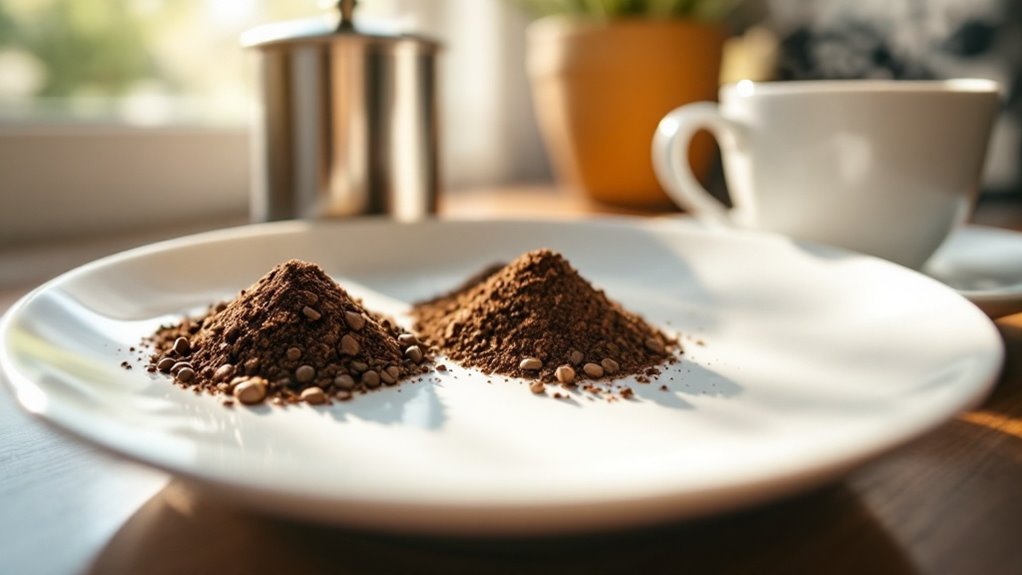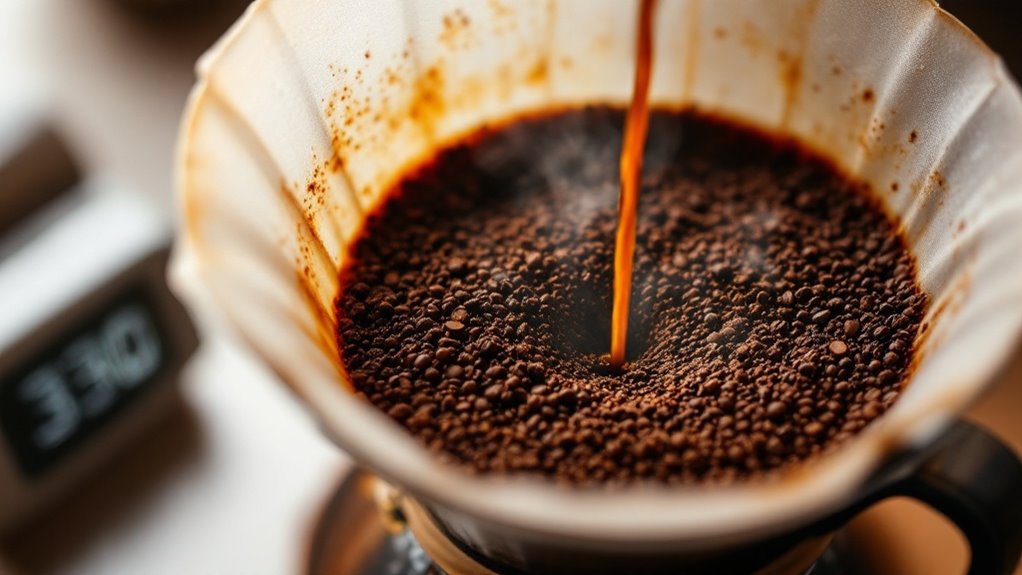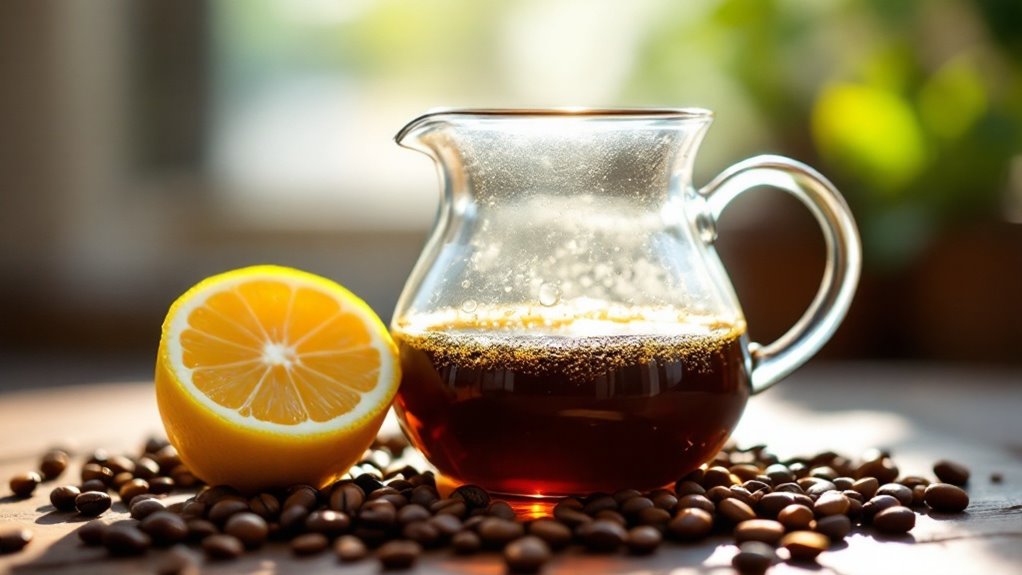







The art of brewing coffee is a delicate dance between science and intuition. When you extract coffee, you're pulling flavors from the grounds, but the balance is everything—too little, and you're left with a sharp, underwhelming cup; too much, and bitterness takes over. Variables like grind size, water temperature, and brew time play pivotal roles in shaping the final taste. But how do you know when you've hit that sweet spot? Understanding the nuances of extraction can transform your coffee experience, leaving you with a cup that's just right. What's the secret to revealing that perfect balance?
Key Takeaways
- Proper coffee extraction balances sourness, sweetness, and acidity, creating a harmonious flavor profile.
- Under-extraction results in sour, salty, and thin flavors due to insufficient dissolution of coffee compounds.
- Over-extraction leads to bitterness, astringency, and woody notes from excessive dissolution of caffeine and polyphenols.
- Grind size, brew time, and water temperature directly influence extraction, affecting taste intensity and balance.
- Ideal extraction (19–23% yield) highlights sweetness and clarity while avoiding extremes of sourness or bitterness.
The Science Behind Coffee Extraction
Coffee extraction's science hinges on the interplay of solubility, time, and temperature. When you brew coffee, water dissolves approximately 28% of the roasted beans by weight, extracting flavor compounds like acids, sugars, and oils. The remaining 70% consists of insoluble cellulose and plant structure, which don't contribute to taste. Your grind size determines the surface area exposed to water, influencing how quickly these compounds dissolve. Finer grinds increase extraction speed, while coarser grinds slow it down. Water temperature also plays a critical role; hotter water (195–205°F) accelerates extraction, while cooler water under-extracts, leaving flavors unbalanced. Brew time further dictates how much of each compound dissolves, with fast-extracting acids contributing sourness and slow-extracting compounds like bitter alkaloids emerging later. Total dissolved solids (TDS) measure the concentration of extracted compounds in your brew, with ideal extraction yields (EY) ranging between 19% and 23%. Exceeding this range leads to bitterness and astringency, while falling short results in sourness and saltiness. Mathematical models simplify these dynamics, assuming spherical particles and exponential decay in extraction rates, but the real-world process remains a delicate balance of variables.
Key Variables Influencing Extraction
Grind size directly affects extraction speed, with finer particles increasing surface area and accelerating the process, while coarser grinds slow it down. Brew time determines the intensity of extraction, as longer contact periods extract more compounds, while shorter times yield lighter profiles. The coffee-to-water ratio balances concentration, ensuring you achieve the desired strength without over- or under-extraction.
Grind Size Impact
The grind size's influence on coffee extraction is a critical factor in shaping the final flavor profile of your brew. A fine grind increases the surface area of coffee particles, accelerating extraction time and intensifying flavors. However, if not balanced, it can lead to over-extraction, producing bitterness. Conversely, a coarse grind slows extraction, reducing the risk of over-extraction but potentially resulting in under-extraction, which yields sour or weak flavors. For espresso, a fine grind is essential to achieve ideal extraction within the short 25–30-second brew time. In contrast, methods like French press or cold brew require coarser coffee grounds to prevent over-extraction during their longer brew times, which can range from 4 to 12 minutes or more. By adjusting grind size, you directly control the rate at which water interacts with coffee particles, ensuring a balanced extraction. This precision allows you to tailor your brew to highlight desired flavors while avoiding undesirable extremes. Mastering grind size is key to revealing the full potential of your coffee.
Brew Time Control
When brewing coffee, controlling the brew time is essential to achieving the right balance of flavors. Brew time directly influences extraction levels, determining whether your coffee tastes balanced, bitter, or sour. If you extend the brew time too long, over-extraction occurs, pulling out excessive compounds that result in bitter flavors and astringency. Conversely, shortening the brew time leads to under-extraction, leaving you with a cup that's overly acidic and sour. To achieve a balanced extraction, you must align brew time with other variables like grind size and water temperature. For example, a finer grind size requires a shorter brew time to avoid over-extraction, while a coarser grind benefits from a longer brew time to guarantee proper extraction. Consistency in brew time is also critical; it secures repeatable results, allowing you to refine your technique. Whether you're brewing espresso (25–30 seconds) or pour-over (2:30–3:30 minutes), mastering brew time control is key to revealing the desired flavor profile in your coffee.
Coffee-to-Water Ratio
Nailing the coffee-to-water ratio is essential for dialing in the perfect cup, as it directly affects extraction and flavor balance. A standard ratio of 1:16 (1 gram of coffee to 16 grams of water) provides a balanced brew, but you can adjust it to suit your taste or brew methods. Increasing the ratio to 1:15 strengthens the brew, slowing extraction and raising Total Dissolved Solids (TDS), which intensifies flavor profiles but risks over-extraction if the coffee grind is too fine. Conversely, a 1:17 ratio lightens the brew, speeding extraction and lowering TDS, which can lead to under-extraction if the grind is too coarse. The coffee-to-water ratio also interacts with water temperature and brew time, influencing how flavors develop during coffee brewing. For example, a French press may benefit from a 1:15 ratio to compensate for its coarser grind, while pour-over methods often thrive at 1:16. Experiment with ratios to fine-tune your coffee, guaranteeing the grind size and water quality align with your desired outcome. Precision in this variable guarantees ideal extraction and a well-balanced cup.
Stages of Coffee Extraction and Flavor
As coffee extraction progresses, it moves through distinct flavor stages—salty, sour, sweet, bitter, and, if over-extracted, undesirable plant-like notes. Initially, under-extracted coffee exhibits sharp sourness and acidity, accompanied by a salty edge, as the water dissolves only the most soluble compounds. This stage lacks the balance and sweetness that define a well-brewed cup. As extraction continues, you reach the sweet spot, where the coffee achieves a harmonious blend of flavors, with the sourness and acidity balanced by natural sweetness. This ideal stage is influenced by variables like grind size, brew time, and water temperature, which control the rate of flavor dissolution. Beyond the sweet spot, over-extracted coffee emerges, marked by a bitter taste and astringency as less desirable compounds dissolve. If extraction continues unchecked, the coffee develops plant-like or woody notes, signaling that the brew has gone too far. Understanding these flavor stages helps you identify the sweet spot, ensuring a balanced and flavorful cup while avoiding the pitfalls of under-extracted or over-extracted coffee.
Identifying Under-Extracted Coffee
You'll recognize under-extracted coffee by its pronounced sourness and salty undertones, which result from insufficient extraction of sugars and bitter compounds. The absence of sweetness, coupled with a sharp, abrupt finish, further signals under-extraction. These flavors indicate that the brew hasn't reached the ideal extraction yield, leaving key elements undissolved.
Sourness and Saltiness Indicators
When coffee is under-extracted, sourness and saltiness become prominent indicators of insufficient brewing. Sourness arises when the extraction process fails to dissolve enough of the coffee's sweet and bitter compounds, leaving behind sharp, acidic notes that dominate the flavor profile. This imbalance creates a tart, almost citrus-like taste that can feel overly aggressive on your palate. Saltiness, another hallmark of under-extraction, often accompanies sourness, contributing to a sharp, briny sensation that detracts from the coffee's natural complexity. These flavors emerge because the water hasn't had enough time or contact to extract the full range of desirable compounds, leaving the brew unbalanced and incomplete. The result is a taste that feels thin and unsatisfying, with a quick, abrupt finish that lacks depth. To identify under-extraction, focus on these sour and salty cues, as they signal that your coffee hasn't reached its full potential. Adjusting grind size, brew time, or water temperature can help mitigate these issues, ensuring a more balanced and enjoyable extraction.
Lack of Sweetness Signs
A lack of sweetness in your coffee is a clear sign of under-extraction, signaling that the brew hasn't fully developed its desirable flavor compounds. When coffee extraction is insufficient, the total dissolved solids (TDS) in your cup remain low, leaving the sweetness underdeveloped. Instead of a balanced, sugary flavour, you'll notice a sharp, sour taste dominating the profile. This sourness often masks any potential sweetness, making the coffee taste hollow or empty.
In coffee tasting, sweetness is a hallmark of proper extraction, resembling notes of brown sugar or toffee. Under-extracted coffee, however, lacks this lingering, pleasant finish. Instead, it may end abruptly, leaving a sour or salty aftertaste. The absence of sweetness highlights the imbalance, making the brew less enjoyable and less complex.
To identify under-extracted coffee, pay attention to the finish. If it feels thin, lacks depth, or leaves no trace of sugary richness, it's likely under-extracted. Adjust your grind size, brew time, or water temperature to increase extraction and bring out the sweetness, ensuring a more balanced and satisfying cup.
Recognizing Over-Extracted Coffee
Over-extracted coffee is often marked by a pronounced bitterness and astringency, stemming from the excessive dissolution of compounds like caffeine and polyphenols during brewing. These compounds, when over-extracted, dominate the flavour profile, masking the nuanced sweetness and acidity that define a well-balanced cup. The bitterness is sharp and lingering, while the astringency creates a dry, rough mouthfeel as polyphenols bind to proteins in your saliva. This results in a hollow or flat taste, where the coffee lacks depth and complexity, often overshadowing the unique characteristics of the bean's origin.
Dark roasts are particularly susceptible to over-extraction due to their higher solubility, which releases bitter compounds more readily during brewing. You'll notice the coffee lacks clarity, with the bitterness overpowering any subtle notes. The astringency can also make the coffee feel overly harsh on your palate, detracting from its drinkability. Recognizing these signs—bitter, astringent, and flat flavours—helps you identify over-extracted coffee and adjust your brewing parameters to achieve a more balanced extraction.
Achieving the Ideal Extraction Balance
Achieving the ideal extraction balance requires careful control of brewing variables to avoid the pitfalls of over or under-extraction. Your goal is to achieve an extraction yield (EY) between 19% and 23%, with 22% EY often delivering the most balanced and complex flavor profile. Under-extraction, below 18% EY, results in sour, salty, and thin flavors, while over-extraction, above 22% EY, introduces bitterness and astringency. To maintain this balance, you must fine-tune your grind size, brew time, and water-to-coffee ratio. A finer grind increases surface area, speeding up extraction, while a coarser grind slows it down. Adjusting brew time guarantees you extract enough soluble compounds without overdoing it. A proper water-to-coffee ratio, typically 1:15 to 1:18, secures even saturation and consistent extraction. When these variables align, your coffee will exhibit sweetness, clarity, and balanced acidity, with a long-lasting, pleasant finish. This harmony in coffee extraction highlights the true flavor profile of your beans, creating a satisfying and nuanced cup.
Adjusting Brew Variables for Better Taste
Fine-tuning your brew variables is essential for revealing the full potential of your coffee's flavor profile. Start by adjusting one variable at a time to isolate its impact. For instance, a finer grind increases surface area, enhancing extraction and bringing out sweetness and complexity, while a coarser grind reduces extraction, minimizing bitterness. Brew time also plays a critical role; extending it allows more compounds to dissolve, balancing acidity and sweetness, whereas shortening it prevents over-extraction and bitterness. The coffee-to-water ratio is another key factor; a higher ratio (e.g., 1:15) intensifies flavor strength, while a lower ratio (e.g., 1:18) yields a lighter, more delicate cup. Aim for a brewing temperature between 195–205°F (91–96°C) to optimize extraction, as temperatures outside this range can lead to under-extraction or over-extraction. Finally, guarantee uniform extraction by evenly saturating the grounds and avoiding channeling through proper tamping or stirring. By carefully adjusting these variables, you'll achieve a balanced, flavorful cup of brewing coffee.
Advanced Techniques for Perfect Extraction
Mastering advanced extraction techniques can elevate your coffee brewing from good to exceptional. Start by understanding extraction theory: finer grind sizes increase surface area, accelerating the rate at which coffee extracts and intensifying flavor. Maintain water temperature between 195–205℉ (91–96℃) to optimize solubility and achieve balanced coffee extracts. Use a refractometer to measure Total Dissolved Solids (TDS), aiming for 18–22% to guarantee ideal extraction without over- or under-extraction. For espresso, experiment with pressure profiling to control extraction dynamics. Adjusting pressure during the shot can enhance sweetness and clarity, as detailed in resources like Barista Hustle. Secure even bed depth and consistent tamping pressure to prevent channeling, which disrupts uniform extraction. By combining these techniques—fine-tuning grind size, monitoring TDS, and leveraging pressure profiling—you'll reveal nuanced flavors and elevate your brewing precision. Advanced extraction isn't just about following steps; it's about understanding how variables interact to create a harmonious cup. With practice, you'll refine your approach, transforming your coffee into a consistently exceptional experience.
Disclosure: As an Amazon Associate, I earn from qualifying purchases.






